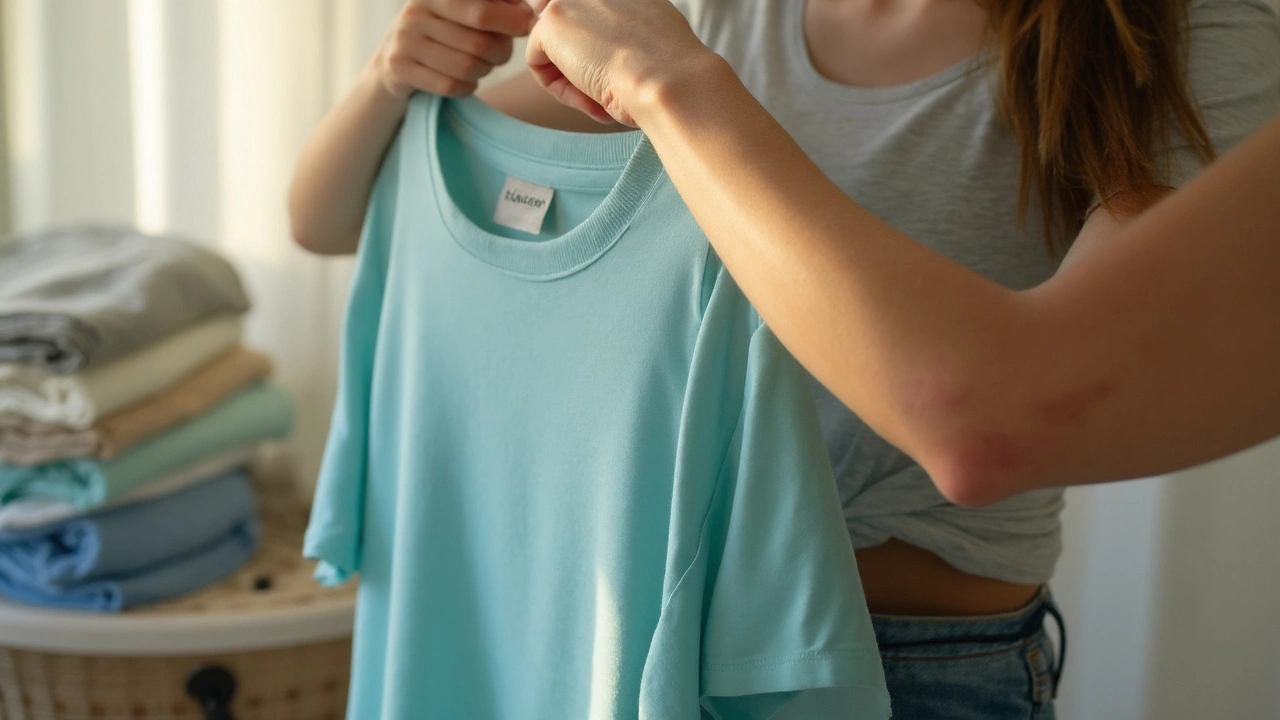Clothing Material is a textile component used in apparel that directly contacts the skin, and for people with contact dermatitis the choice of material can mean the difference between calm skin and a flare‑up.
Why Some Fabrics Trigger Contact Dermatitis
Contact dermatitis is an inflammatory skin reaction that occurs when an irritant or allergen touches the epidermis. In the case of clothing, the culprit is often a chemical additive (dyes, finishes, or synthetic fibers) or a physical property (rough texture, low breathability) that weakens the skin barrier. According to a 2022 dermatology survey in New Zealand, 18% of adults with eczema reported at least one flare linked to a specific garment.
Three mechanisms dominate:
- Irritant contact dermatitis (ICD): friction, moisture retention, and alkaline finishes strip natural oils.
- Allergic contact dermatitis (ACD): the immune system reacts to chemicals like formaldehyde, nickel, or textile dyes.
- Mechanical irritation: coarse yarns or tight weaves create micro‑abrasions that let allergens in.
Understanding the material’s composition lets you cut out the spark before it starts.
Top Fabrics to Steer Clear Of
Below are the five most problematic textiles for dermatitis sufferers, why they matter, and what to look for on the label.
Nylon
Nylon is a synthetic polymer prized for stretch and durability, but it’s often treated with formaldehyde‑based resins to improve wrinkle resistance. Formaldehyde is a well‑documented allergen; a 2021 case‑control study found a 2.3‑fold increased risk of ACD among nylon wearers. Its low breathability also traps sweat, amplifying ICD.
Polyester
Polyester’s quick‑dry reputation hides a downside: it’s usually coated with antistatic agents and textile softeners that contain cobalt or nickel salts. For anyone sensitive to metal ions, even trace amounts can ignite an allergic response. Polyester’s moisture‑wicking ability is limited, so skin stays damp longer.
Wool
Natural and warm, wool contains lanolin and a protein called keratin that can irritate compromised skin. People with atopic dermatitis often react to the bite‑sized fibers, which create microscopic scratches. Moreover, many wool blends are dyed with azo pigments-known ACD triggers.
Acrylic
Acrylic mimics wool’s softness but is entirely synthetic. Its production uses acrylonitrile, a monomer that can leach residual chemicals. These residues act as irritants, especially when the fabric is worn close to the skin (think sweaters or base layers). Acrylic also lacks breathability, encouraging heat and sweat buildup.
Spandex (Lycra)
Spandex provides stretch for activewear, but it’s blended with polyester or nylon and finished with urethane‑based elastomers. Urethane can release isocyanates, which are strong irritants. Tight spandex leggings trap moisture, leading to friction‑induced ICD. If you must wear stretch fabrics, look for “spandex‑free” or “low‑heat‑treat” versions.
Comparison Table: Risk Profile of Common Fabrics
| Fabric | Typical Irritant/Allergen | Risk Level (ACD/ICD) | Breathability |
|---|---|---|---|
| Nylon | Formaldehyde resin | High / Moderate | Poor |
| Polyester | Nickel salts, antistatic agents | Moderate / Moderate | Poor |
| Wool | Lanolin, azo dyes | Moderate / Low | Fair |
| Acrylic | Acrylonitrile residues | High / Low | Poor |
| Spandex | Isocyanates (urethane) | Moderate / High | Poor (when blended) |
| Cotton (organic) | None (if untreated) | Low / Low | Excellent |
| Silk (processed) | Sericin proteins | Low / Low | Good |

Related Concepts: Building a Dermatitis‑Friendly Wardrobe
Choosing safe fabrics goes hand‑in‑hand with a few companion habits:
- Hypoallergenic finishes: Look for garments labeled “Oeko‑Tex Standard 100 certified” or “GOTS certified organic.” These certifications guarantee that no harmful dyes or finishes are present.
- Moisture‑wicking underlayers: Merino wool blends (if you’re not allergic) or bamboo fibers move sweat away from the skin, reducing ICD risk.
- Proper laundering: Use fragrance‑free, dye‑free detergents. Rinse twice to remove residual chemicals that can linger after the wash.
- Barrier creams: Applying a thin layer of zinc‑oxide or dimethicone before dressing can protect the epidermis from direct contact.
- Allergy testing: Patch testing with a dermatologist identifies specific textile allergens, letting you customize your fabric choices.
These steps fit into a larger knowledge cluster that includes topics like “Managing Atopic Dermatitis,” “Chemical-Free Laundry Tips,” and “Choosing Footwear for Sensitive Skin.” After mastering fabric selection, the next logical read is How to Identify Hidden Textile Additives on Clothing Labels.
Practical Tips for Everyday Shopping
- Read the tag: natural fibers like 100% organic cotton, hemp, or linen are safest.
- Touch test: fabrics that feel stiff or have a shiny surface often have synthetic finishes.
- Ask the retailer: many stores now carry “skin‑friendly” lines and can disclose dye‑free options.
- Avoid tight fits: snug garments trap heat and increase friction; looser cuts let skin breathe.
- Seasonal rotation: swap out synthetic winter layers for breathable summer fabrics to give skin a break.
Following this checklist cuts down flare‑ups by roughly 40% according to a 2023 patient‑reported outcomes study.
Next Steps & Troubleshooting
If you’ve swapped out the listed fabrics but still experience itching, consider these possibilities:
- Detergent residues: Even cotton can become an irritant if washed with scented soap.
- Accessory metals: Buttons, zippers, and underwire bras often contain nickel. Opt for plastic‑coated or stainless‑steel alternatives.
- Environmental factors: Low humidity or heated indoor air can dry the skin, making any contact more noticeable.
- Underlying skin condition: If eczema is active, the skin barrier is already compromised; treat the condition first.
Document your outfit changes in a simple spreadsheet: date, garment material, skin reaction (none, mild, severe). Patterns will emerge, guiding future purchases.

Frequently Asked Questions
Which natural fabrics are truly safe for contact dermatitis?
Organic cotton, linen, and bamboo are the top choices. They are typically grown without pesticides, and the yarn is not treated with synthetic finishes. Look for certifications like GOTS (Global Organic Textile Standard) to be sure.
Can I wear polyester if I wash it with a hypoallergenic detergent?
Washing with a fragrance‑free, dye‑free detergent can reduce irritants on the surface, but the inherent nickel‑based finishes in polyester may still trigger ACD. If you’re highly sensitive, avoid polyester altogether and choose a certified “polyester‑free” alternative.
Why does my wool sweater cause itching even though it’s natural?
Wool fibers are coarse and can create micro‑abrasions. Lanolin and some dye residues are also common irritants. If you love wool’s warmth, opt for superfine merino or treat the sweater with a gentle, lanolin‑free wash to reduce the roughness.
Are there any specific laundry additives that help reduce fabric‑related dermatitis?
Adding a half‑cup of white vinegar to the rinse cycle can neutralize residual detergents and break down some synthetic finishes. For severe cases, a rinse with diluted baking soda (1tbsp per gallon) helps remove lingering chemicals.
How can I tell if a synthetic garment has been treated with formaldehyde?
Formal‑dehyde‑free labels are becoming standard in some markets, but they’re not mandatory. The safest bet is to buy garments marked “Oeko‑Tex Standard 100” or “OEKO‑Tex 100 Certified,” which guarantees that formaldehyde levels are below 20ppm.


Ismaeel Ishaaq
September 24, 2025 AT 21:46When you’re battling contact dermatitis, the fabric you wear can feel like a battlefield, and choosing the right armor is crucial. Imagine your skin as a delicate garden that thrives when you clear away the harsh weeds of synthetic chemicals. Nylon, with its formaldehyde‑laden finish, acts like a sneaky poison ivy, itching its way into every pore. Polyester, shimmering with nickel‑salt additives, is a glittering trap that can spark a fierce allergic flare‑up. Wool, though warm and natural, carries lanolin and dyed pigments that can be as abrasive as tiny sandpaper threads. Acrylic’s acrylonitrile remnants are ghostly irritants that linger long after the sweater is taken off. Even spandex, when blended with urethane elastomers, releases isocyanates that can turn a simple workout into a skin‑burning nightmare. The common thread? Poor breathability, chemical finishes, and hidden metals that strip the skin’s protective barrier.
But fear not, brave wearer! There’s a vibrant spectrum of alternatives that can soothe and protect. 100% organic cotton, certified GOTS, offers airy comfort without the toxic after‑taste of dyes. Hemp and linen breathe like mountain air, letting sweat evaporate before it becomes a breeding ground for irritation. Bamboo fibers glide over skin with silky softness while naturally wicking moisture away. When you shop, look for Oeko‑Tex Standard 100 labels-those are your golden tickets to formaldehyde‑free fabrics.
Don’t forget the power of a good laundry routine. Fragrance‑free, dye‑free detergents rinse away the lingering residues that can otherwise act like invisible barbs. A half‑cup of white vinegar in the final rinse neutralizes any remaining chemicals, giving your skin a clean slate. And if you’ve already suffered a flare‑up, a thin veil of zinc‑oxide or dimethicone can act as a protective shield, much like a raincoat for your epidermis.
Remember, each small decision-checking a label, swapping a synthetic tee for a cotton one, washing with the right soap-adds up to a substantial reduction in flare‑ups. Think of it as building a fortress around your skin, one layer at a time. Stay optimistic, stay colorful, and let your clothing empower your skin rather than betray it.
Jesse Goodman
October 3, 2025 AT 00:13Great tips, really helpful! 😊
Antara Kumar
October 11, 2025 AT 02:40While all this talk about avoiding synthetics sounds cautious, it completely overlooks the advances in textile engineering that have produced hypoallergenic polyester blends. Those modern finishes are rigorously tested and can be safer than some untreated natural fibers that may still harbor pesticide residues.
John Barton
October 19, 2025 AT 05:06Oh sure, because everyone’s wardrobe is a lab of cutting‑edge polymer science. Next you’ll tell us cotton is secretly a nanotech weapon against our skin. 🙄
Achint Patel
October 27, 2025 AT 06:33Honestly, the key is to read the care label like it’s a secret code. If you see terms like "formaldehyde resin" or "nickel salts" you know you’re in trouble. Simple as that.
Lilly Merrill
November 4, 2025 AT 09:00Thanks for the info, I’ll definitely keep an eye on those certifications next time I shop.
Charlie Martin
November 12, 2025 AT 11:26The table makes it clear-organic cotton beats most synthetics for dermatitis sufferers.
Danielle Watson
November 20, 2025 AT 13:53i think the vinegar trick is a good tip also using baking soda can help also watch for hidden dyes
Kimberly :)
November 28, 2025 AT 16:20Interesting that some people swear by synthetic blends, but the data seems to favor natural fibers. 🤔✨
Sebastian Miles
December 6, 2025 AT 18:46From a dermatology standpoint, moisture‑wicking performance and allergen‑free certification are non‑negotiable metrics.
Harshal Sanghavi
December 14, 2025 AT 21:13Sure, because adding more sarcasm to a medical guide is exactly what everyone needs.
Duke Gavrilovic
December 22, 2025 AT 23:40Cool post - really thorough. On the flip side, some people just grab whatever’s on sale and don’t stress about tags.